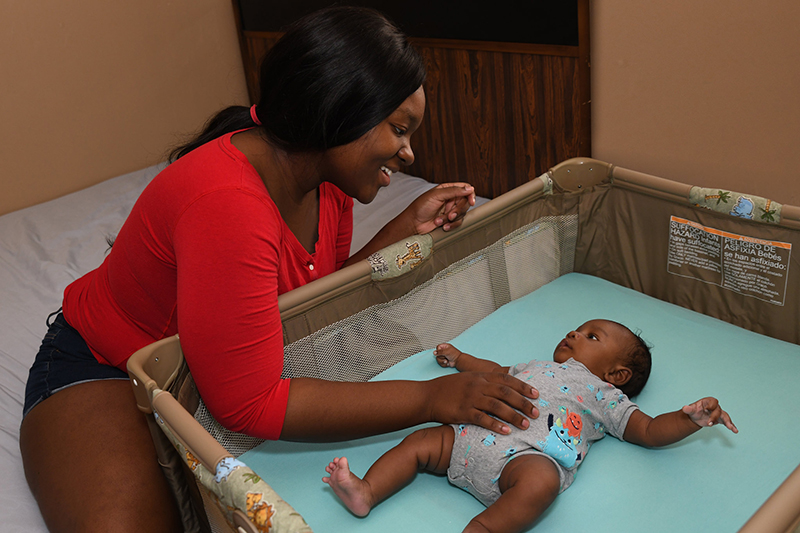Three-year partnership will develop D.C. project for infant safe sleep education and outreach

The National Institutes of Health and the District of Columbia government are teaming up to raise awareness among District parents and caregivers about how to reduce the risk of sudden infant death syndrome (SIDS) and other sleep-related causes of infant death, such as accidental suffocation.
Although many U.S. states and territories have seen decreases in sleep-related infant deaths over the last few years, the District’s Office of the Chief Medical Examiner reported an increase in these deaths between 2014 and 2018 (PDF 7.5 MB). Sleep-related causes of death include SIDS—the sudden, unexplained death of an infant younger than 1 year of age that does not have a known cause, even after a full investigation—or suffocation, overlay, or other deaths from an unsafe sleep environment.
The Safe to Sleep© campaign, led by the NIH’s Eunice Kennedy Shriver National Institute of Child Health and Human Development (NICHD), will work with the District of Columbia Office of the Chief Medical Examiner, the Thrive by Five DC initiative and other D.C. groups to understand information or service gaps related to safe infant sleep and determine how those gaps contribute to deaths and risks for families in the District. The collaboration, known as the D.C. Safe Sleep Education and Outreach Project, will then develop and implement the outreach and awareness campaign to inform D.C. parents and caregivers about how they can bridge these gaps.
“By combining science with safe sleep practices and tailoring safe sleep messages and activities to area parents and caregivers, this new collaboration has the potential to save infant lives,” said Diana W. Bianchi, M.D., NICHD Director. “We are excited to work with our colleagues in the District of Columbia government and other local groups to help babies and families thrive.”
“Every parent or caregiver wants their child to have the best start in life,” said Dr. Francisco J. Diaz, Chief Medical Examiner for the District. “The D.C. Safe Sleep Education and Outreach Project will provide families with valuable information on how to provide the safest possible sleeping environment for their infants, helping to reduce sleep-related deaths in the District and providing opportunities for each child to have a strong start.”
“I am excited about this collaboration and the partnerships it is sparking to move us toward sustainable solutions and more positive outcomes for our babies. Together with families, we can make sure our babies have everything they need to thrive, and that includes safe sleep environments and practices,” said Dr. Faith Gibson Hubbard, Executive Director of Thrive by Five.
NICHD and collaborators, including the American Academy of Pediatrics (AAP) and the Centers for Disease Control and Prevention (CDC), launched the Safe to Sleep® campaign as the Back to Sleep campaign in 1994 to raise awareness among caregivers and healthcare providers about ways to reduce the risk of SIDS. The collaborators expanded the campaign to Safe to Sleep® in 2012 to focus on reducing risks for other sleep-related causes of infant death, such as suffocation.
The campaign translates safe infant sleep recommendations from the AAP into messages, educational resources, and outreach materials for lay and provider audiences. Key messages include always placing infants on their backs to sleep, using a firm and flat sleep surface such as a mattress in a safety-approved crib, and breastfeeding.
Recent research findings jointly published by NICHD, CDC, and the Health Resources and Services Administration suggest that other safe sleep behaviors, such as keeping loose bedding and soft objects out of baby’s sleep area and room sharing with parents instead of bed sharing are not as well known. As a result, parents and caregivers may unknowingly be creating an unsafe sleep environment and putting their babies at risk.
With guidance and technical support from NICHD, the Office of the Chief Medical Examiner, Thrive by Five DC and other partners will assess the District’s existing infant mortality data and safe sleep education and resources to determine if additional support systems or communications are needed to ensure that parents and caregivers make optimal choices related to safe infant sleep. Through focus groups and online surveys, they will identify any barriers to safe sleep practices among area residents and develop interventions to address those barriers. They will also identify and test safe sleep messages and materials, emphasizing the needs of and feedback from communities with the highest number of infant sleep-related deaths.
After testing is complete, these messages will provide the basis for the campaign, which will be a comprehensive outreach effort that will include community events, local media and community faith leaders, public service announcements, and media outreach. Dr. Diaz’s office notes that the D.C.-focused project will likely launch in late 2021.
###
About the Eunice Kennedy Shriver National Institute of Child Health and Human Development (NICHD): NICHD leads research and training to understand human development, improve reproductive health, enhance the lives of children and adolescents, and optimize abilities for all. For more information, visit https://www.nichd.nih.gov.
About the National Institutes of Health (NIH): NIH, the nation’s medical research agency, includes 27 Institutes and Centers and is a component of the U.S. Department of Health and Human Services. NIH is the primary federal agency conducting and supporting basic, clinical, and translational medical research, and is investigating the causes, treatments, and cures for both common and rare diseases. For more information about NIH and its programs, visit https://www.nih.gov.

 BACK TO TOP
BACK TO TOP